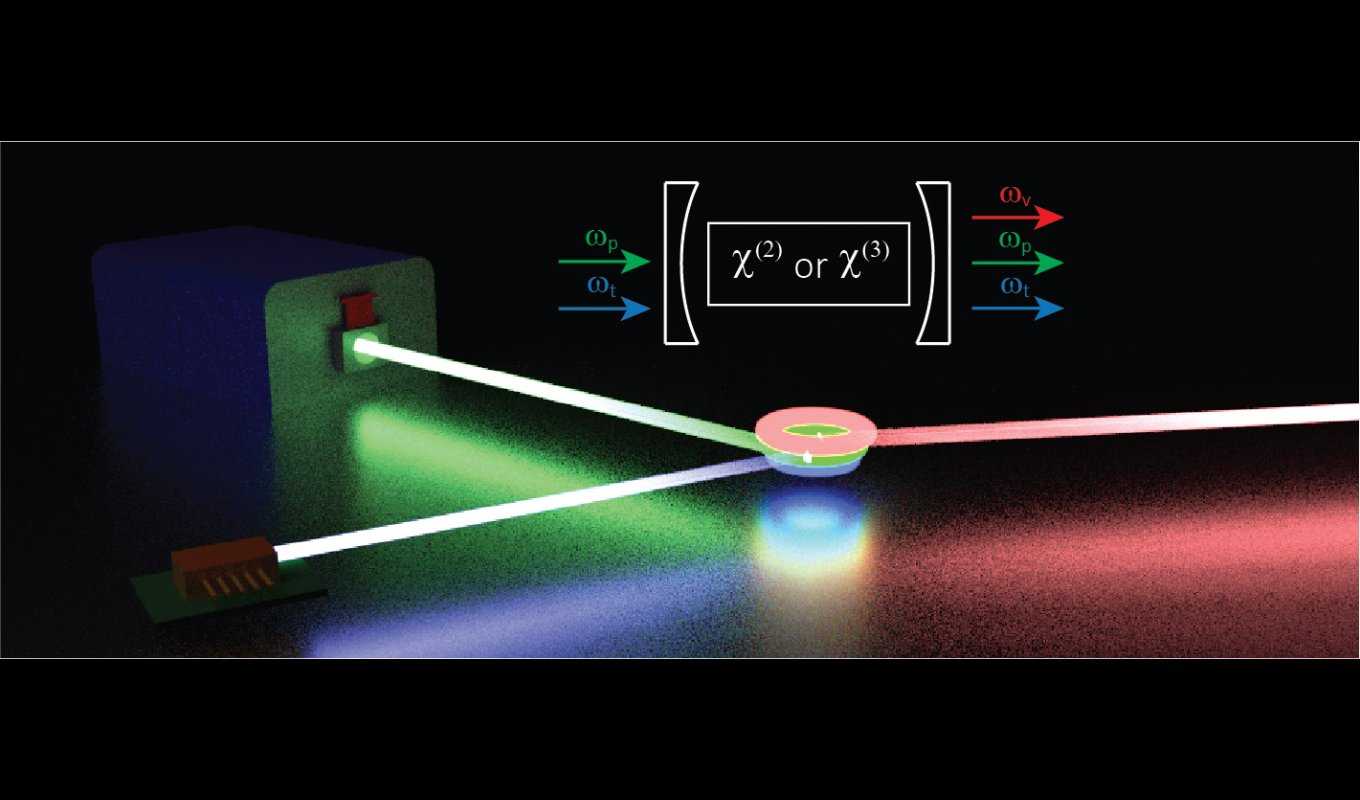Nonlinear Nanophotonics

Concept of spectral translation - a near-infrared pump mediates translation of an input signal in the telecom to an output in the visible (Lu et al, Nature Photonics, 2019).
Motivation
Nonlinear optics plays an important role in the optical sciences. Processes such as harmonic generation, sum- and difference-frequency generation, and four-wave mixing enable the creation of coherent laser light at wavelengths for which access to direct optical transitions may be difficult. Nonlinear wave mixing and frequency conversion are at the heart of quantum technologies based on entangled photon pairs and squeezed states of light, which enable fundamental tests of nonlocality and sensing beyond the standard quantum limit. Nonlinear optics is also core to the generation and stabilization of optical frequency combs that play an important role in optical frequency metrology, including optical clocks.
Nanophotonics technology offers many new opportunities to explore physics and technology based on nonlinear optics. Aside from the potential to realize the above functionality in a platform suited for scalable manufacturing and deployment outside of a laboratory, the wide variety of materials, strong optical field confinement, and controllable dispersion possible in nanofabricated photonic structures open new avenues for nonlinear science that are not easily reached otherwise. Some examples of nonlinear nanophotonics research that we are pursuing are given below.
Summary of our work
Microresonator frequency combs
Damped and driven nonlinear resonators can support phase-stable states of the electromagnetic field that correspond to mode-locked pulses in time and equidistant combs of spectral teeth in frequency. These systems can act as true frequency combs - that is, as precision metrological tools through which optical frequencies can be measured and synthesized. Our research on microresonator frequency combs (microcombs) partly consists of device-level investigations in which we consider how to optimize comb performance (e.g., in terms of spectral extent, operating power, etc) and realize novel geometries that support dispersion profiles of relevance to comb generation. Recent examples include demonstrations of octave-spanning soliton microcombs and an understanding of the interplay between Kerr and thermal dynamics in these devices (Li et al, Optica, 2017), the prediction that phase-locked two-color soliton states can be supported in suitably modified microring resonator geometries (Moille et al, Optics Letters, 2018), and the suppression of thermo-refractive effects in soliton microcombs operating in a cryogenic environment (Moille et al, Phys. Rev. Applied, 2019). With John Bowers' group at UC Santa Barbara, we were recently able to demonstrate Kerr soliton generation in the AlGaAs-on-insulator platform, which is distinguished by its large effective nonlinearity that can lead to ultra-low power operation (Moille et al, Laser and Photonics Reviews, 2020).
We are also interested in the application of microcomb devices to systems, including optical frequency synthesizers that can realize Hz-level accuracy and precision (Spencer et al, Nature, 2018) and optical atomic clocks (Newman et al, Optica, 2019). These system-level applications and demonstrations help define requirements on the microcomb devices - e.g., octave-spanning spectra, suitable power for f-2f self-referencing, etc, that in turn guide us in understanding how the physical parameters that govern microcomb formation (e.g,. dispersion, nonlinearity, and coupling) might be usefully tailored.
We strongly benefit from several collaborations on this work, including with NIST Boulder, UC Santa Barbara, Draper Laboratory, and Raytheon BBN Technology.
Optical parametric oscillators and spectral translation
We also work on nonlinear optical processes related to microcomb generation, namely, optical parametric oscillation and spectral translation. For optical parametric oscillation, we are interested in the generation of coherent laser radiation with output frequencies that are widely separated from the pump frequency so that we can, for example, access visible wavelengths that may be hard to reach otherwise, using a near-infrared pump source that is compact and readily available (Lu et al, Optica, 2019). Most recently, we have shown the ability to generate green, yellow, orange, and red light from a common 780 nm pump source, where the output color is primarily dictated by the resonator geometry (Lu et al, Optica, 2020). Similarly, for spectral translation, we are interested in realizing highly efficient four-wave mixing processes in which existing high-performance laser sources can have their outputs shifted to wavelengths of relevance to spectroscopy and metrology (Lu et al, Nature Photonics, 2019).
Finally, we have recently begun exploring how to better utilize an effective second-order nonlinear interaction that can be realized in silicon nitride through the combination of its third-order nonlinearity and a DC electric field. For example, recently we showed that this combination can lead to efficient second harmonic generation in microresonators (Lu et al, Nature Photonics, 2021), where in this case the DC field is photoinduced.
Quantum frequency conversion and entanglement swapping sources
Our interest in these topics strongly overlaps with our research in integrated quantum photonics (https://groups.jqi.umd.edu/srinivasan/research/integrated-quantum-photonics), and is described further in that section. For these applications in quantum science, we continue to draw upon basic concepts from nonlinear nanophotonics, modulated by specific considerations relevant to quantum science (e.g., generation of noise photons, bandwidth requirements for matching with other quantum systems, etc).
Selected representative publications from our recent work are included below; a full list can be found on the Publications page.